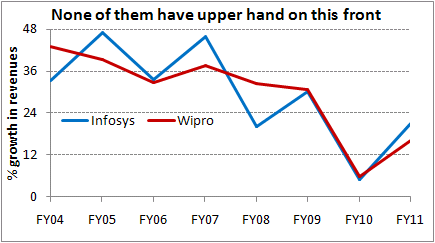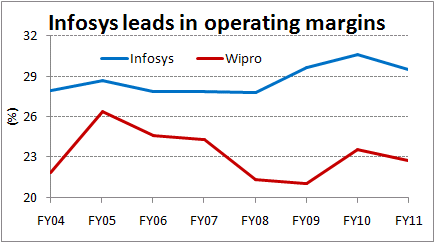- Home
- Outlook Arena
- Apr 11, 2012 - Infosys v/s Wipro: Strategies and numbers
Infosys v/s Wipro: Strategies and numbers
In the first article of the series, we compared the revenue distribution of Infosys and Wipro. In the next article, we talked about the business strategies adopted by the companies in the past. In this article, we are going to compare Infosys and Wipro on the basis of their present business strategies, management quality and some of the financial performance parameters.
Present Business Strategy
In the past one year, a lot of things have changed for Wipro. In the beginning of year 2011, the company decided to dismantle its Joint-CEO model. The new structure now focuses on four key industry verticals - 'Banking, Financial Services and Insurance (BFSI)', 'Energy & Utility', 'Retail and consumer products' and 'Healthcare'. These have been identified by the company as the core momentum verticals. The new restructured Wipro is more simple, agile and customer centric. There is a single account manager in a particular vertical who would concentrate on not just acquiring new customers but also focus on getting more business from the existing client pool. This one point accountability would remove confusion and multi-point intervention and thus help in establishing a better client relationship. Going forward, Wipro plans to increase investments in analytics, mobility and cloud services which would help the company increase the non-linear business.
On the other side of the table, Infosys has completed 30 years of its journey. Now it is into its third phase of journey, Infosys 3.0 after pioneering Global Delivery Model (GDM) and developing capabilities of providing end-to-end solutions and consulting services in the first two phases. Now the management of the company is talking about "Building Tomorrow's Enterprise". They are focusing on transformation, optimization and innovation to serve their clients in the best possible way. The company would continue its go-to-markets strategy through industry verticals. Towards this, the management has consolidated all its industry verticals into four verticals- "Financial Services and Insurance", "Manufacturing", "Retail, Logistics, Life Sciences and healthcare" and "Energy & Utilities, Communications and Services". On the client delivery side, the business offerings are structured into three categories- "Consulting and System Integration", "Business IT" and "Products, platforms and Solutions". At present, Business IT contributes almost 60% of total revenues. Now, the company aims to draw one third of its revenues from each of these service lines. The company has kept Business Process Outsourcing (BPO) and high growth areas such as cloud and enterprise mobility as separate units which are outside the main structure.
In a nutshell, both the companies seem to be following the similar strategies to grow their business in the future.
Management Quality
Undoubtedly, both the companies have equally competent as well as ethical management teams. However, in case of Wipro, it has been more of a family business driven by its visionary leader. On the other hand, in the case of Infosys, it has been more of a professionally managed firm wherein a set of professionals are key to decision making.
Revenues Growth
The consolidated revenues of Infosys grew at an average rate of almost 29% (compounded annual growth rate or CAGR) from FY03 to FY11. During the same period, Wipro's IT services revenues also grew by the same pace of 29% (CAGR).

|
| Source: Equitymaster Research, Company's Annual Reports |
Both the company fared equally well as far as revenues growth is concerned. However, for Wipro, some of the growth came on the back of acquiring some small companies. On the other hand, Infosys mostly followed organic growth path.
Operating margins
On operating margin front, Infosys is way ahead of Wipro. Average EBIT (Earnings before interest and taxes) margin for last eight years is almost 29% for Infosys as compared to 23% for Wipro.

|
| Source: Equitymaster Research, Company's Annual Reports |
Global Delivery Model has been a differentiating factor for Infosys in the past. The company pioneered GDM which became the de-facto standard in the software industry later on. On the back of superior project delivery capability and bigger brand name, Infosys did command premium pricing for its services. That resulted into higher margins for the company. On operating margin front, Infosys is a clear winner.
In the fourth and final article of the series, we would talk more on financial performance. And discuss the valuations of the companies.
Equitymaster requests your view! Post a comment on "Infosys v/s Wipro: Strategies and numbers". Click here!
1 Responses to "Infosys v/s Wipro: Strategies and numbers"


Abrar
Aug 6, 2013where is the fourth article?